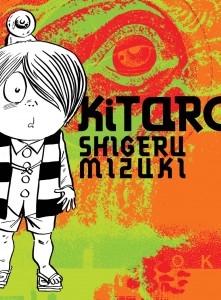By Shigeru Mizuki. Released in Japan as “Gegege no Kitaro” by (among others) Kodansha, serialized in various magazines. Released in North America by Drawn & Quarterly.
There was already a sampler of Kitaro a few years back, also by Drawn & Quarterly, but this new collection appears to be the equivalent of a multi-volume best-of, apparently signed off on by Mizuki himself, who gave the editor a test to see if he could choose the stories that Mizuki himself would have chosen (he got all but one). And so we see some earlier Kitaro manga from the late 60s, including a lengthy chapter from the magazine Garo that shows off how Kitaro came to be, and helps you understand that the otherwise generic zombie on the cover really is one of the main characters. It’s a grim little tale, more serious than the rest of the stories in this volume, possibly as it lacks the series’ main drawing point.
See, Kitaro is a nice kid, mostly (his ethics can be rather questionable from a human perspective), but he is essentially Mickey Mouse. He’s the title character and appears in every story, but what the readers really want is someone a bit more fallible and funny. And you can’t get much funnier or more fallible than Nezumi Otoko, which translates to Rat Man. He is the Donald Duck of this series, only Donald was never quite so evil. Nezumi Otoko will do absolutely anything for money, including tricking old rich men out of their life savings, luring respectable young manga editors to their yokai-influenced deaths, and take advantage of the dead – multiple times. Even when he’s not being an ass, he’s usually a coward, always the first to run away. This, of course, makes him a marvelous character, the best reason to read this series. He’s beloved in Japan (for a certain definition of beloved), and was used as narrator for Mizuki’s Showa history.
The other big reason to read the series is the yokai, who veer from the silly to the terrifying, but they’re all dangerous. Neko Musume shows up here, and those who recall her cute moe appearance in some of the more recent Kitaro animes will be startled by this bowl-cut girl who tries to literally eat Nezumi Otoko when she first sees him (to be fair, he deserved it – he always does). The Gyuki and Hideri Gami are more typical straight-up monsters, in the former case even managing to possess Kitaro, who gets to enjoy a rare turn attacking people. Kuckily, Kitaro is made of stern stuff, able to survive even being dropped in a volcano. Also luckily, this is very much not a serialized story. Tales need to end in a certain number of pages, so the yokai rarely get to do much before Kitaro has won and they’re off on their next adventure. (The anime was airing as these manga chapters were running, and you can see references to the insanely catchy theme song in these final ‘the adventure continues’ panels.)
Even if you aren’t a fan of manga history or yokai stories, this is still a must purchase. It’s also fairly child-friendly, despite a few scares. I am eagerly awaiting more.


